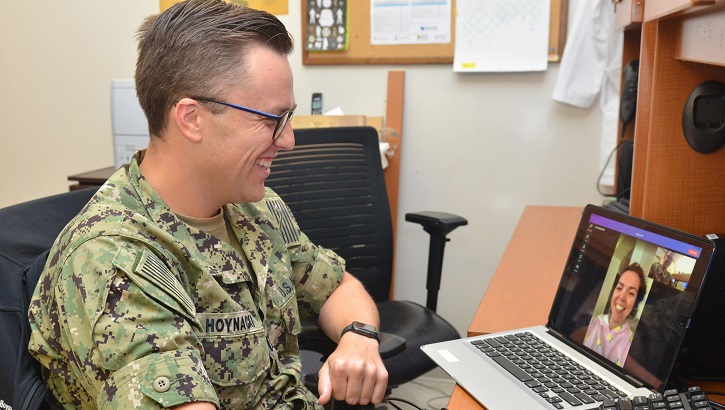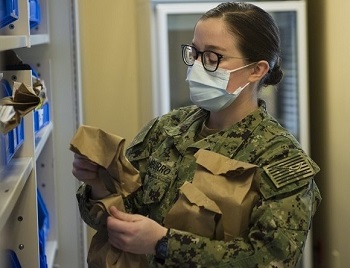MTFs respond to COVID-19 with increased telehealth, drive-thrus
 Lt. Adam Hoynacki, a physician at Naval Hospital Jacksonville’s Family Medicine Clinic, conducts a Navy Care virtual health visit. Like other military virtual health systems, Navy Care offers a live, virtual visit with a clinician, from the patient's smartphone, laptop, or computer. Patients can use it from work, home or anywhere that offers privacy. (Photo by Jacob Sippel, Naval Hospital Jacksonville.)
Lt. Adam Hoynacki, a physician at Naval Hospital Jacksonville’s Family Medicine Clinic, conducts a Navy Care virtual health visit. Like other military virtual health systems, Navy Care offers a live, virtual visit with a clinician, from the patient's smartphone, laptop, or computer. Patients can use it from work, home or anywhere that offers privacy. (Photo by Jacob Sippel, Naval Hospital Jacksonville.)
The Military Health System’s response to the COVID-19 pandemic included practical solutions to complex medical and logistical problems at military medical treatment facilities.
As COVID-19 has spurred innovations in the way health care is delivered, virtual health, or telemedicine, has risen to the task of maintaining social distancing while offering providers, service personnel, and retirees and their beneficiaries the medical input they so critically need.
Through virtual health, “The Military Health System has coordinated policy, expanded video conferencing capability, increased on-demand clinical access and educated thousands of providers on safely providing care,” said Army Col. (Dr.) Sean Hipp, director, Virtual Medical Center, Brooke Army Medical Center, Texas.
“This is a revolution in military medicine that we hope will continue to expand safe, high quality, convenient care to garrison, but also be leveraged to support our most sacred mission of the deployed service member in harm’s way,” Hipp noted.
Many COVID-19 patients live in areas with limited critical care expertise and capacity. The Joint Tele-Critical Care Network (JTCCN) “leverages virtual health to extend critical-care resources and treatment at a distance, similar in concept to how air traffic control systems track and direct planes to ensure they — and their passengers — safely reach their destinations,” said Dr. Simon Pincus, chief of the Defense Health Agency’s Connected Health Branch, during a recent presentation. “The JTCCN provided almost 1,200 days of coverage to more than 300 unique patients in 61 intensive care unit beds across 11 spoke sites from January 2020 to June 2020.”
The DHA is also exploring a partnership with the Department of Veterans Affairs to establish a single federal tele-critical care network to provide care to any of the 1,700 VA or 400 DHA ICU beds.
The pandemic also saw an expansion in the use of the nursing advice line (NAL) and the implementation of a phone screening tool for COVID, with overall call volume up approximately 25% during the year.
The goal of the NAL is to alleviate patient concerns, provide multiple sources of evidence-based advice and protect patients and medical staff by offering telephone and, in some cases, video visits.
 Hospital Seaman Apprentice Gianna Tamburro, assigned to the Naval Medical Readiness Training Command, organizes prescriptions alphabetically by patient name at the Naval Health Clinic Charleston Pharmacy at Joint Base Charleston, S.C. The NHCC Pharmacy altered their customer service operations to have the primary way to obtain a prescription be through the drive-thru because of COVID safety precautions. (Photo by Airman Sara Jenkins, Joint Base Charleston Public Affairs.)
Hospital Seaman Apprentice Gianna Tamburro, assigned to the Naval Medical Readiness Training Command, organizes prescriptions alphabetically by patient name at the Naval Health Clinic Charleston Pharmacy at Joint Base Charleston, S.C. The NHCC Pharmacy altered their customer service operations to have the primary way to obtain a prescription be through the drive-thru because of COVID safety precautions. (Photo by Airman Sara Jenkins, Joint Base Charleston Public Affairs.)
To minimize the risk of exposure to the beneficiaries and military medical treatment facility (MTF) staff, the NAL added capabilities to allow the scheduling of beneficiary virtual (telephone) visits with its care team. At its peak on March 19, the NAL had 10,247 calls. The numbers gradually declined but hit another high in July, DHA Healthcare Optimization Division Chief Regina Julian said. The screening tool uses questions from Centers for Disease Control and Prevention-based guidelines to assess a patient’s risk for having COVID-19.
Between May 12 and Dec. 10, there were 6,602 page views and 5,176 users on the COVID-19 symptom checker website. A total of 576,421 unique patients have viewed their COVID-19-related test results online, Julian reported.
Additionally, the virtual support to operational force (ADVISOR) line, enabled on-demand provider-to-provider teleconsultation.
One onsite effort was to test asymptomatic patients thought to have COVID-19. Patients were sent to Naval Hospital Bremerton, Washington, from their respective commands, along with patients awaiting elective surgeries and those deemed necessary for administrative purposes. This testing led to new insights about the infection rates of the disease.
MTF pharmacies found ways to get patients their prescriptions with a minimum of patient-staff interaction by responding to DHA guidance on prescribing during COVID-19; while adhering to and state and local social-distancing requirements.
Each pharmacy has tailored solutions to fit its physical layout, staffing capacity and patient populations.
Some pharmacies, such as Brooke Army Medical Center, Texas, set up curbside pickup within 48 hours once the need for social distancing during the pandemic became known.
Since March 2020, the drive-through staff at Walter Reed National Military Medical Center (WRNMMC) has served more than 16,066 patients, amounting to approximately 59,444 prescriptions dispensed. That is approximately 10% of total patients served at the drive-through site, according to the medical center’s public affairs office.
The success of drive-throughs and curbside pickup has enabled new, convenient solutions that will continue across MTFs for the foreseeable future.
In September, WRNMMC opened a permanent prescription drive-through pick-up, which replaced earlier, more temporary, iterations.
“When conditions are met, it is the most efficient point of service of all our pharmacies, with wait times averaging one minute or less,” said Army Maj. Hyun Cho, chief, WRNMMC Department of Pharmacy.